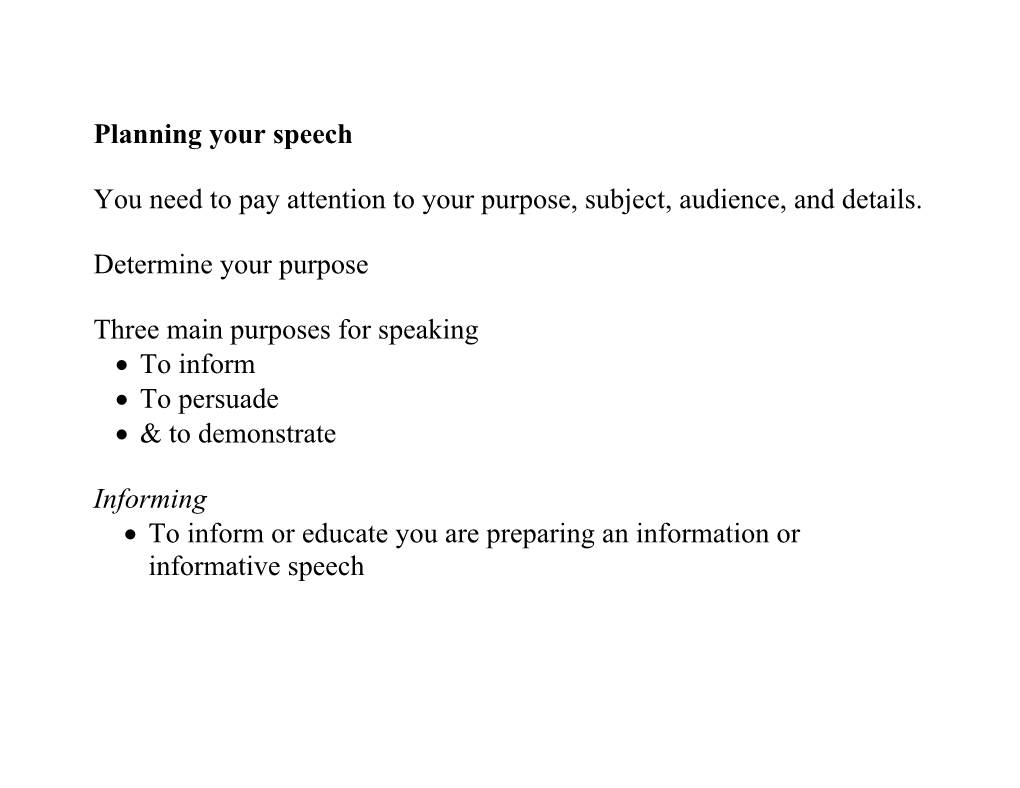Planning your speech
You need to pay attention to your purpose, subject, audience, and details.
Determine your purpose
Three main purposes for speaking
- To inform
- To persuade
- & to demonstrate
Informing
- To inform or educate you are preparing an information or informative speech
Persuading
- If your purpose is to argue for or against something you are preparing a persuasive speech
Demonstrating
- If your purpose is to show how to do something or show how something works, you are preparing a demonstrative speech.
Select a specific subject
A good speech starts with a good subject – one that truly interests you & your audience.
Choose the right subject
- Make sure it meets the requirements of the assignment.
Know your subject
- Know your subject well or can learn about it in a short time.
Choose a specific subject
- Make sure that your subject is specific enough to cover in the time allowed.
Consider your audience
- Choose your subject carefully – Show you care about the audience by choosing an interesting subject.
- Be clear – Organize your speech so clearly the audience get the point immediately.
- Anticipate questions – Try to think of questions your audience will want answers to – answer them in your speech.
- Make it enjoyable – Use thought provoking quotations, interesting anecdotes, and a little humor (when appropriate).
- Be brief – Speak only as long as you must to make your point.
Collect interesting details
Sources of information
- Tap your memory – If your speech is based on an experience, write down the facts, details and feelings as you remember them.
- Talk with people – Discuss your subject with a variety of people who may be able to provide details from their experience.
- Get firsthand experience – Experiencing or trying out your subject is especially important for demonstration speeches.
- Search the library – Make sure you check different library sources including books, magazines, pamphlets, and videos.
- Explore the Internet – Check appropriate Web sites and newsgroups for information.
But be careful of what you find on the Web.
Look for…
Photographs, maps, models, artifacts, charts, objects and other graphics.
Create some of these yourself and use them.
WRITING YOUR SPEECH
If you are writing a short speech you’ll want to use note cards and not that many.
For a longer speech an outline might work best.
If you give a persuasive speech you might want to use a word for word script.
Whatever you choose you have to have an effective introduction, body, and conclusion.
Introduction
A good introduction sets the tone and direction of your speech by …
- Getting the attention of your audience
- Introducing your topic
- Stating your central idea or purpose
Start-Up Ideas
To help the audience focus on your topic …
- Ask a thought provoking question
- Tell a funny story or anecdote
- Give a short demonstration, or attention getting visual aid
- Make a strong statement about why the topic is important to you and the audience.
- Share an appropriate quotation related to your topic.
Stating your thesis
After you’ve considered your purpose, subject and audience -- & gathered the information, you need to write your thesis statement.
You can begin the statement with My purpose is… and finish with your specific speech topic.
Example from Writer’s Inc. book:
“My purpose is to persuade my classmates that we cannot depend on the Social Security system for our retirement funds, so we need to start our own savings plans now.”
Body
If you’re giving your opinion about something back up your point of view with logical reasons and evidence.
Organize your details effectively as you can.
Ways to do this:
- Order of Importance
Arrange information according to it importance – greatest to least greatest or vice-versa.
- Chronological Order
Arrange information according to time – the order in which things take place.
- Comparison/Contrast
Give information about subjects by comparing them (showing similarities) & contrasting them (showing differences).
- Cause and Effect
Give information about a situation, a problem or a process by sharing its cause & effects.
- Order of Location
Arrange information about subjects according to where things are located in relation to each other.
(An informational speech about the anatomy of a person.)
- Problem/Solution
Describe a problem & then present the solution.
Conclusion
The conclusion of your speech ought to leave your audience focused on the most important points of your message.
A good conclusion
-Helps your audience understand what they have heard
-Why what you said is important
-& what they should do about it
- Tell one last interesting fact or story.
(Good way to end an informative speech.)
- Explain why the topic is important.
(Good way to end a persuasive speech.)
- Sum up the most important ideas in your speech.
(This is a good way to end a demonstrative speech.)
REHEARSING & PRESENTING YOUR SPEECH
Rehearse your speech until you are comfortable with it.
Ask for feedback.
Before you speak
- Check your equipment & visual aids before you start.
- Check your outline, note cards, or manuscript – make sure it’s in the right order.
- Stand, walk up & face the audience.
As you speak
- Speak loudly & clearly
- Don’t rush. Read carefully if using a manuscript – glance every now and then at your note cards, outline.
- Think about what you are saying, add feeling to your voice.
- Use appropriate gestures to help communicate.
- Look at the audience as you speak, communicate with facial expressions.
After you speak
- Ask anyone if they have any questions.
- Conclude the presentation by gathering up your things & walking to your seat.
